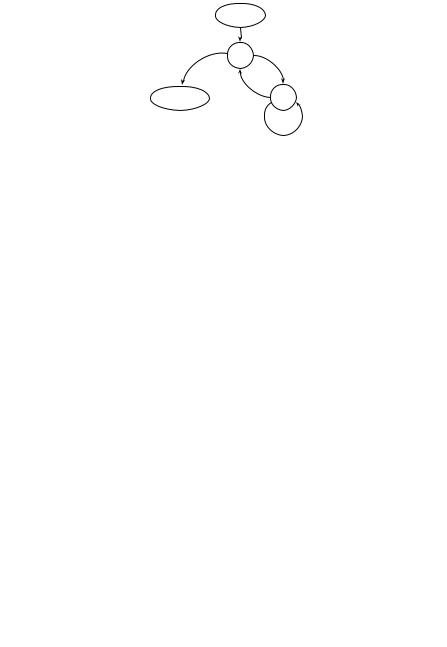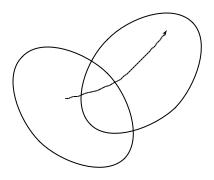
Bradley, Manna. The Calculus of Computation, Springer, 2007
.pdf
128 5 Program Correctness: Mechanics
@pre
@post sorted(rv , 0, |rv | − 1) int[] BubbleSort(int[] a0) {
int[] a := a0;
for |
|
|
|
|
|
|
|
−1 ≤ i < |a| |
|
|
|||
@L1 |
: 2 |
partitioned(a, 0, i, i + 1, |a| − 1)3 |
||||
|
4 |
sorted(a, i, |a| − 1) |
5 |
|||
(int i := |a| − 1; |
i > 0; i := i − 1) { |
|
||||
for |
|
|
|
|
|
|
|
|
|
i < |
a 0 ≤ j ≤ i |
|
|
|
|
21 ≤partitioned| | |
(a, 0, i, i + 1, |a| − 1)3 |
|||
@L2 : |
6 |
partitioned(a, 0, j − 1, j, j) |
7 |
|||
|
|
4 |
|
|
|
5 |
|
|
6 |
sorted(a, i, |a| − 1) |
7 |
||
(int j := 0; j < i; j := j + 1) { if (a[j] > a[j + 1]) {
int t := a[j]; a[j] := a[j + 1]; a[j + 1] := t;
}
}
}
return a;
}
Fig. 5.17. BubbleSort with loop invariants
Performing a depth-first exploration, the first basic path starts at the precondition and ends at the outer loop invariant at L1:
(1)
@pre ; a := a0;
i := |a| − 1;
@L1 : −1 ≤ i < |a| partitioned(a, 0, i, i + 1, |a| − 1) sorted(a, i, |a| − 1)
The second basic path starts at L1 and ends at the inner loop invariant at L2 (recall that the annotation is checked after the loop initialization j := 0):
(2)
@L1 : −1 ≤ i < |a| partitioned(a, 0, i, i + 1, |a| − 1) sorted(a, i, |a| − 1) assume i > 0;
j := 0;
@L2 :
The third and fourth basic paths follow the inner loop, each handling one assumption on the guard a[j] > a[j + 1] of the if statement:

|
|
|
5.2 Partial Correctness 129 |
|
|
|
|
(3) |
|
@L2 |
: |
1 ≤ i < |a| 0 ≤ j ≤ i |
partitioned(a, 0, i, i + 1, |a| − 1) |
|
|
|
partitioned(a, 0, j − 1, j, j) sorted(a, i, |a| − 1) |
||
assume j < i; |
|
|
||
assume a[j] > a[j + 1]; |
|
|
||
t := a[j]; |
|
|
||
a[j] := a[j + 1]; |
|
|
||
a[j + 1] := t; |
|
|
||
j := j + 1; |
|
|
||
@L2 |
: |
1 ≤ i < |a| 0 ≤ j ≤ i |
partitioned(a, 0, i, i + 1, |a| − 1) |
|
|
|
partitioned(a, 0, j − 1, j, j) sorted(a, i, |a| − 1) |
||
|
|
|
(4) |
|
@L2 |
: |
1 ≤ i < |a| 0 ≤ j ≤ i |
partitioned(a, 0, i, i + 1, |a| − 1) |
|
|
|
partitioned(a, 0, j − 1, j, j) sorted(a, i, |a| − 1) |
||
assume j < i; |
|
|
||
assume a[j] ≤ a[j + 1]; |
|
|
||
j := j + 1; |
|
|
||
@L2 |
: |
1 ≤ i < |a| 0 ≤ j ≤ i |
partitioned(a, 0, i, i + 1, |a| − 1) |
|
|
|
partitioned(a, 0, j − 1, j, j) sorted(a, i, |a| − 1) |
||
The fifth basic path starts at L2, exits the inner loop, and decrements i on its way to L1:
(5)
@L2 |
: |
1 ≤ i < |a| 0 ≤ j ≤ i partitioned(a, 0, i, i + 1, |a| − 1) |
|
|
|
partitioned(a, 0, j − 1, j, j) sorted(a, i, |a| − 1) |
|
assume j ≥ i; |
|
||
i := i − 1; |
|
||
@L1 |
: −1 ≤ i < |a| partitioned(a, 0, i, i + 1, |a| − 1) sorted(a, i, |a| − 1) |
||
The final basic path starts at L1, exits the outer loop, and then exits the function, returning the (presumably sorted) array a:
(6) |
sorted(a, i, |a| − 1) |
@L1 : −1 ≤ i < |a| partitioned(a, 0, i, i + 1, |a| − 1) |
|
assume i ≤ 0; |
|
rv := a; |
|
@post sorted(rv , 0, |rv| − 1) |
|
Figure 5.18 visualizes these basic paths. |
|
Example 5.15. Figure 5.19 lists BubbleSort with runtime assertions at L3 and a di erent set of loop invariants at L1 and L2 relevant for proving the runtime assertions. Six basic paths correspond in structure to those of Figure 5.18, although their content varies based on the new precondition, postcondi-

130 5 Program Correctness: Mechanics
@pre
|
|
(1) |
|
|
L1 |
(6) |
(5) |
(2) |
@post |
|
L2 |
(3), (4)
Fig. 5.18. Visualization of basic paths of BubbleSort
@pre @post
int[] BubbleSort(int[] a0) { int[] a := a0;
for
@L1 : −1 ≤ i < |a|
(int i := |a| − 1; i > 0; i := i − 1) { for
@L2 : 0 < i < |a| 0 ≤ j ≤ i
(int j := 0; j < i; j := j + 1) { @L3 : 0 ≤ j < |a| 0 ≤ j + 1 < |a|; if (a[j] > a[j + 1]) {
int t := a[j]; a[j] := a[j + 1]; a[j + 1] := t;
}
}
}
return a;
}
Fig. 5.19. BubbleSort with runtime assertions
tion, and loop invariants. These basic paths ignore the runtime assertion at L3. Then one additional basic path ends at the runtime assertion:
(7)
@L2 : 0 < i < |a| 0 ≤ j ≤ i assume j < i;
@L3 : 0 ≤ j < |a| 0 ≤ j + 1 < |a|

5.2 Partial Correctness |
131 |
@pre 0 ≤ ℓ u < |a| sorted(a, ℓ, u) @post rv ↔ i. ℓ ≤ i ≤ u a[i] = e
bool BinarySearch(int[] a, int ℓ, int u, int e) { if (ℓ > u) return false;
else {
int m := (ℓ + u) div 2;
if (a[m] = e) return true; else if (a[m] < e) {
@R1 : 0 ≤ m + 1 u < |a| sorted(a, m + 1, u); return BinarySearch(a, m + 1, u, e);
} else {
@R2 : 0 ≤ ℓ m − 1 < |a| sorted(a, ℓ, m − 1); return BinarySearch(a, ℓ, m − 1, e);
}
}
}
Fig. 5.20. BinarySearch with function call assertions
5.2.2 Basic Paths: Function Calls
Like loops, recursive functions create an unbounded number of paths within programs. But just as loop invariants cut loops to produce a finite number of basic paths, function specifications cut function calls.
Recall that the function postcondition is a relation between the return value rv and the formal parameters. A function’s postcondition summarizes the e ects of calling it. We use these summaries to replace function calls in basic paths.
Remark 5.16. The postconditions of the functions of a program need only include information that is relevant for proving the given specification, so the summaries may be incomplete. Ignoring irrelevant aspects of functions reduces the size of annotations. Chapter 6 discusses techniques for developing function specifications.
The replacement of function calls by function summaries makes the listing of basic paths (and the resulting analysis described in Section 5.2.4) local to functions. Basic paths do not span multiple functions. However, recall that the function postcondition is guaranteed to hold on return only when the function precondition is satisfied on entry. To ensure that the precondition is satisfied, each instance of a function call generates an extra basic path in which the called function’s precondition is asserted. An example clarifies this discussion.
Example 5.17. Figure 5.8 lists BinarySearch with its function specification. BinarySearch contains two (recursive) function calls. In Figure 5.20, each function call is protected by a function call assertion at R1 and R2. Each assertion is constructed by applying a substitution to BinarySearch’s precondition

132 5 Program Correctness: Mechanics
F [a, ℓ, u, e] : 0 ≤ ℓ u < |a| sorted(a, ℓ, u) .
The first function call is BinarySearch(a, m + 1, u, e), so the function call assertion at R1 is F σ1, where
σ1 : {a 7→a, ℓ 7→m + 1, u 7→u, e 7→e} .
The notation of Section 1.5 allows us to write F [a, m + 1, u, e].
The second function call is BinarySearch(a, ℓ, m −1, e), so the function call assertion at R2 is F [a, ℓ, m−1, e]. These assertions are treated in the same way as other assertions, such as runtime assertions. So far, we have the following basic paths:
(1)
@pre 0 ≤ ℓ u < |a| sorted(a, ℓ, u) assume ℓ > u;
rv := false;
@post rv ↔ i. ℓ ≤ i ≤ u a[i] = e
(2)
@pre 0 ≤ ℓ u < |a| sorted(a, ℓ, u) assume ℓ ≤ u;
m := (ℓ + u) div 2; assume a[m] = e; rv := true;
@post rv ↔ i. ℓ ≤ i ≤ u a[i] = e
(3)
@pre 0 ≤ ℓ u < |a| sorted(a, ℓ, u) assume ℓ ≤ u;
m := (ℓ + u) div 2; assume a[m] 6= e; assume a[m] < e;
@R1 : 0 ≤ m + 1 u < |a| sorted(a, m + 1, u)
(5)
@pre 0 ≤ ℓ u < |a| sorted(a, ℓ, u) assume ℓ ≤ u;
m := (ℓ + u) div 2; assume a[m] 6= e; assume a[m] ≥ e;
@R2 : 0 ≤ ℓ m − 1 < |a| sorted(a, ℓ, m − 1)
Because BinarySearch lacks loops, each basic path starts at the function precondition.

5.2 Partial Correctness |
133 |
It remains to consider paths (4) and (6), which pass through the recursive function calls and end at the postcondition. Paths (3) and (5) end in the function call assertions at R1 and R2 protecting these function calls. Since they assert that the called BinarySearch’s precondition holds, we can assume that the returned values obey the postcondition of BinarySearch in each of the calling contexts. Therefore, we can use the function postcondition as a summary of the function call:
(4)
@pre 0 ≤ ℓ u < |a| sorted(a, ℓ, u) assume ℓ ≤ u;
m := (ℓ + u) div 2; assume a[m] 6= e; assume a[m] < e;
assume v1 ↔ i. m + 1 ≤ i ≤ u a[i] = e; rv := v1;
@post rv ↔ i. ℓ ≤ i ≤ u a[i] = e
The lines
assume v1 ↔ i. m + 1 ≤ i ≤ u a[i] = e; rv := v1;
arise as follows. First, translate the return statement
return BinarySearch(a, m + 1, u, e);
into an assignment to rv , as usual:
rv := BinarySearch(a, m + 1, u, e);
Next, given that the precondition holds (from path (3)), assume that the postcondition holds. Therefore, summarize the function call with a relation based on BinarySearch’s postcondition,
G[a, ℓ, u, e, rv] : rv ↔ i. ℓ ≤ i ≤ u a[i] = e .
Specifically, the relation is G[a, m + 1, u, e, v1], where v1 is a fresh variable that captures the return value. In the basic path, assume this relation; then use the return value v1 in the assignment:
assume G[a, m + 1, u, e, v1]; rv := v1;
These are the penultimate lines of (4). Hence, (4) replaces the function call BinarySearch(a, m + 1, u, e) with a summary based on the function postcondition. Now reasoning about the basic path does not require reasoning about all of BinarySearch at once.

134 |
5 Program Correctness: Mechanics |
|
|
@pre |
|
|
(3),(4) |
(5),(6) |
|
R1 (1) (2) |
R2 |
|
(4) |
(6) |
|
@post |
|
Fig. 5.21. Visualization of basic paths of BinarySearch
Construct the final basic path for the function call BinarySearch(a, ℓ, m − 1, e) similarly:
(6)
@pre 0 ≤ ℓ u < |a| sorted(a, ℓ, u) assume ℓ ≤ u;
m := (ℓ + u) div 2; assume a[m] 6= e; assume a[m] ≥ e;
assume v2 ↔ i. ℓ ≤ i ≤ m − 1 a[i] = e; rv := v2;
@post rv ↔ i. ℓ ≤ i ≤ u a[i] = e
Again, v2 is a fresh variable.
Figure 5.21 visualizes these basic paths. Paths (4) and (6) are shown to
pass through locations R1 and R2, respectively. |
|
For the general case, consider function f with prototype |
|
@pre F [p1, . . . , pn] |
|
@post G[p1, . . . , pn, rv ] |
|
type0 f(type1 p1, . . . , typen pn) |
|
Suppose that f is called in context |
|
w := f(e1, . . . , en); |
|
where e1, . . . , en are expressions. Then augment the calling context with the function call assertion:
@ F [e1, . . . , en];
w := f(e1, . . . , en);
Treat this new assertion the same as any assertion: it results in at least one basic path ending in
. . .
@ F [e1, . . . , en]
5.2 Partial Correctness |
135 |
Finally, in basic paths that pass through the function call, replace the function call by an assumption and assignment constructed from the postcondition, where v is a fresh variable:
. . .
assume G[e1, . . . , en, v]; w := v;
. . .
Note that rv need not have type bool as in BinarySearch. For example, for a function with prototype
@pre @post rv ≥ x int g(int x)
the statement
w := g(n + 1);
is summarized in basic paths as follows:
assume v ≥ n + 1; w := v;
5.2.3 Program States
Before presenting the final step in proving partial correctness, we formalize program state. A program state s is an assignment of values of the proper type to all variables. The program variables include a distinguished variable pc, the program counter. It holds the current location of control.
Example 5.18. The state
s : {pc 7→L1, a 7→[2; 0; 1], i 7→2, j 7→0, t 7→2, rv 7→[]}
is a state of BubbleSort in which control resides at L1. |
|
A state can be extended to a logical interpretation. Suppose that T is the theory that captures the functions (+, −, etc.) and predicates (=, <, etc.) of the program. Extend a state s to a logical T -interpretation I : (DI , αI ): let DI be all values of the program types; and construct αI by using the assignments of s and adding assignments for all logical functions and predicates so that I is a T -interpretation. Subsequently, when we say a state, we mean either the assignment of program variables to values or the extension to a T - interpretation for the appropriate theory T , depending on the context. When we write s |= F , we mean that I |= F for a T -interpretation I extending s.

136 5 Program Correctness: Mechanics
•s′
|
S |
•s |
F |
wp(F, S) |
|
Fig. 5.22. Weakest precondition |
|
Example 5.19. To extend |
|
s : {pc 7→L1, a 7→[2; 0; 1], |
i 7→2, j 7→0, t 7→2, rv 7→[]} |
to a (TZ TA)-interpretation I : (DI , αI ), let DI be the set of all integers and arrays of integers; and for αI , assign the standard functions to ·[·], ·h· ·i, +,
−, etc.
5.2.4 Verification Conditions
Our goal is to reduce an annotated function to a finite set of FOL formulae, called verification conditions, such that their validity implies that the function’s behavior agrees with its annotations. The reduction to basic paths reduces reasoning about the function to reasoning about a finite set of basic paths. The final reduction from basic paths to VCs requires a mechanism for incorporating the e ects of program statements into FOL formulae. The weakest precondition predicate transformer is the mechanism. A predicate transformer p is a function
p : FOL × stmts → FOL
that maps a FOL formula F FOL and program statement S stmts to a FOL formula.
The weakest precondition wp(F, S) has the defining characteristic that if state s is such that
s |= wp(F, S)
and if statement S is executed on state s to produce state s′, then
s′ |= F .
This situation is visualized in Figure 12.1(a). The region labeled F is the set of states that satisfy F ; similarly, the region labeled wp(F, S) is the set of

5.2 Partial Correctness |
137 |
states that satisfy wp(F, S). Every state s on which executing statement S leads to a state s′ in the F region must be in the wp(F, S) region.
Define the weakest precondition for the two statement types of basic paths introduced in Section 5.2.1:
•Assumption: What must hold before statement assume c is executed to ensure that F holds afterward? If c → F holds before, then satisfying c in assume c guarantees that F holds afterward:
wp(F, assume c) c → F
•Assignment : What must hold before statement v := e is executed to ensure
that F [v] holds afterward? If F [e] holds before, then assigning e to v with v := e makes F [v] hold afterward:
wp(F [v], v := e) F [e]
For a sequence of statements S1; . . . ; Sn, define
wp(F, S1; . . . ; Sn) wp(wp(F, Sn), S1; . . . ; Sn−1) .
The weakest precondition moves a formula backward over a sequence of statements: for F to hold after executing S1; . . . ; Sn, wp(F, S1; . . . ; Sn) must hold before executing the statements. Because basic paths have only assumption and assignment statements, the definition of wp is complete.
Then the verification condition of basic path
@ F S1;
.
.
.
Sn; @ G
is
F → wp(G, S1; . . . ; Sn) .
Its validity implies that when F holds before the statements of the path are executed, then G holds afterward. Traditionally, this verification condition is denoted by the Hoare triple
{F }S1; . . . ; Sn{G} .
Example 5.20. Consider the basic path
(1)
@ x ≥ 0
x := x + 1; @ x ≥ 1
The VC is
